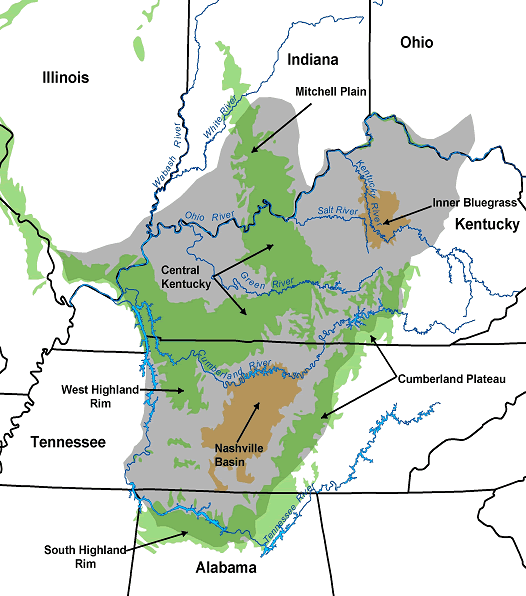What is Karst topography and why should you care? - Clarksville Online - Clarksville News, Sports, Events and Information (original) (raw)
Karst Hydrology Initiative–Study area showing major karst hydrogeologic settings in the Interior Low Plateaus physiographic region. Areas underlain by Lower-Middle Ordovician limestones shown in brown, and areas underlain by Mississippian limestones shown in green. (USGS Map)
Karst topography describes a landscape abundant in sinkholes, disappearing streams and caves.
Clarksville, TN – According to Dr. Phillip Kemmerly, professor of geology at Austin Peay State University (APSU), Clarksville sits in one of the most interesting areas of karst topography in the world.
Clarksville is part of a region known to geologists as the Western Highland Rim Plain. This region includes northern middle Tennessee and extends into western Kentucky where it is called the Pennyroyal Plain and Mammoth Cave Plateau. The only region in the world with more karst features is Slovenia in southern Europe.
Kemmerly divulges that of karst features, sinkholes pose the greatest risk to new and existing construction sites.
“A sinkhole is like a wide-mouth, funnel shaped depression,” says Kemmerly. “This funnel is connected to a Swiss cheese-like system of underground channels that run through the bedrock.”
Sinkholes are created when the surface collapses after supporting rock is dissolved and sediment passes through the channels in the bedrock.
Sinkholes at APSU
APSU has had plenty of experience with sinkholes. The area in front of Harned Hall and Woodward Library were prone to sinkhole collapse until a few years ago. There have also been collapses under Drane Street, Henry Street, College Street and the northeast corner of the McCord Building. There is also the very real possibility of undiscovered holes appearing with little notice virtually anywhere on the campus.
Many of these sinkholes have been repaired—or remediated—but not all of the remediation methods have been effective. Over the course of 30 years, approximately 40 truckloads of rock and gravel were dumped into the sinkhole in front of Harned Hall. These temporary fixes lasted a few months and then the sinkhole would re-emerge.
Eventually a group of engineers was hired to repair the sinkholes. Using Kemmerly as a consultant, they devised a plan to line the sinkhole with a carpet-like material called geotextile. This material functions like a coffee filter because it keeps the gravel and soil used to fill the hole from being washed away by the flow of groundwater. To assist with runoff, a drain was also installed.
What to watch for…
Unchecked, a sinkhole can grow and threaten the foundations of buildings, collapse roads and lead to serious property damage and injury. Some sinkholes are preventable; others can become worse by uneducated attempts to fill them. If you are concerned about the risk of sinkholes, Kemmerly provides some cautionary advice.
Watch for standing water. If you want to reduce the likelihood of a sinkhole forming, make sure you have adequate drainage. “Collapses usually occur shortly after significant periods of rainfall,” Kemmerly says. If water pools around the foundation of your home or office, you may be assisting in the formation of a sinkhole. Make sure that gutters and downspouts carry water away from your house.
Watch what you fill them with. Resist the urge to fill in a sinkhole with junk and refuse. “Something in us wants to fill a hole,” Kemmerly says, “but that’s not always a good thing.” The reason you should not fill sinkholes with refuse is because sinkholes feed the groundwater. In most areas, the groundwater flows at a rate of a few inches to several feet per day. In the karst areas of the Western Highland Rim and Pennyroyal Plain, however, groundwater moves at a rate of 1,000-8,000 feet per day. What pollutes a sinkhole inadvertently pollutes the groundwater, and what pollutes the groundwater in one area can impact the entire groundwater system. Dumping trash in sinkholes not only harms the environment, it is illegal.
Watch where you build. As Clarksville grows, it pushes deeper and deeper into what could be unstable lands. According to Kemmerly, countries in Europe have stricter building codes, making it less likely for homes and businesses to be built over sinkholes. Until stricter building practices are put in place in the U.S., it is up to landowners and contractors to do the research, contact geologists and discover the geological features lurking under ground.
For more information about karst topography or sinkholes in the Clarksville area, contact the APSU School of Geosciences and Agriculture, (931) 221-7454.
